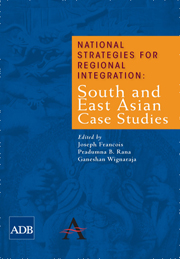7 - People's Republic of China
from East Asian Perspectives
Published online by Cambridge University Press: 05 March 2012
Summary
Introduction
The People's Republic of China (PRC) has achieved great success in developing its economy since it conducted economy-wide reforms and opened itself to the outside world. In less than three decades, the PRC has become a leading world economy, the second largest in terms of foreign direct investment (FDI) inflows, the third largest in foreign trade, the fourth largest in gross domestic product (GDP), and an important engine for global economic growth. One of the key factors for the PRC's success has been its integration into the world economic system, enabling it to use global market resources (markets, capital, and technology). Accession to the World Trade Organization (WTO) has made the PRC economy more open, transparent, and integrated into the world economic system. The PRC's new regional strategy, that is forming free trade agreements (FTAs), as well as its foreign investment strategy, have deepened, and the PRC will continue to intensify its economic integration and cooperation with its partners.
The Asia and Pacific region is the source of most of the PRC's FDI inflows, as well as the principal destination of its exports, with the United States (US) and Japan the two largest markets. East Asia accounts for half of the PRC's foreign trade and more than 70% of FDI inflows. The PRC's trade with South Asia is still small in volume, but it is growing quickly.
- Type
- Chapter
- Information
- National Strategies for Regional IntegrationSouth and East Asian Case Studies, pp. 333 - 382Publisher: Anthem PressPrint publication year: 2009



